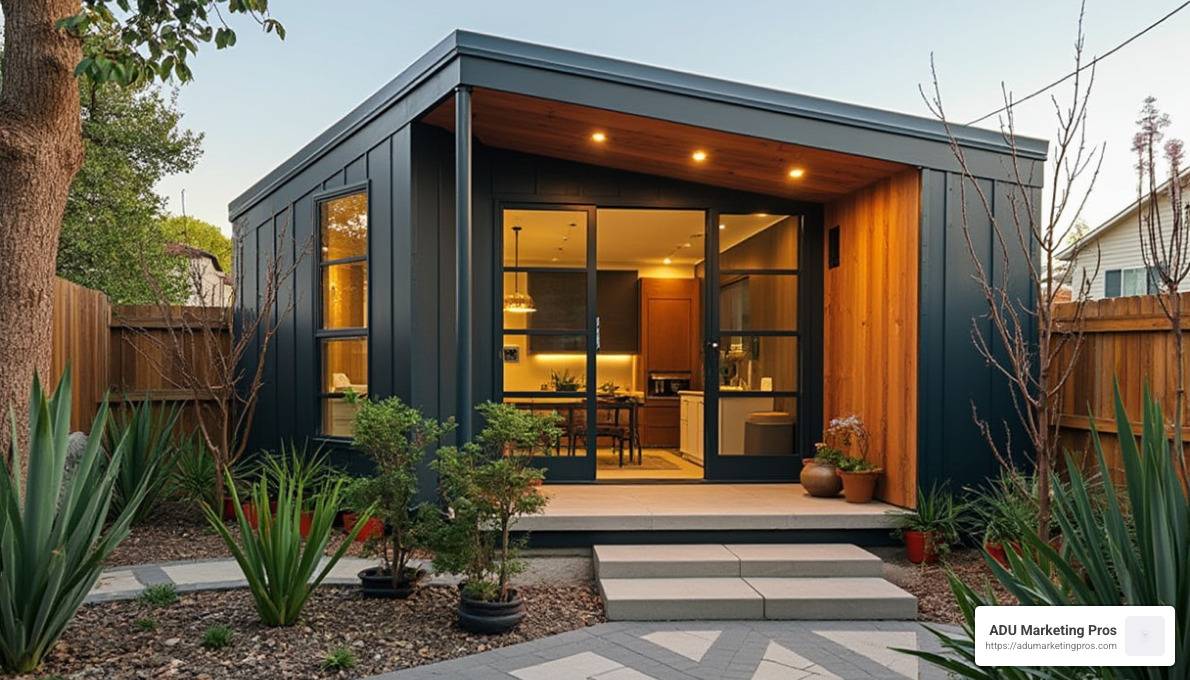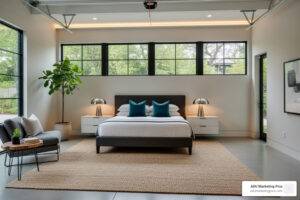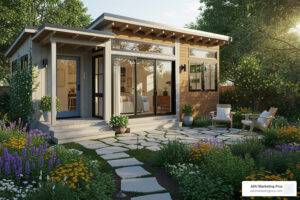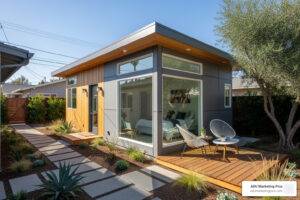ADU design trends are reshaping the future of small-space living, especially in California where regulations are evolving to support these innovative housing solutions. For quick insight, here are the key trends:
- Simplified Legislation: Recent legislative changes have streamlined the ADU approval process, making construction faster and easier.
- Sustainable Design: Eco-friendly materials and layouts are increasingly popular as builders focus on sustainability.
- Smart Home Technology: Integration of modern technology keeps ADUs efficient and appealing.
- Multifunctional Spaces: Flexible and adaptive designs maximize utility without increasing footprint.
- Expanded Layouts: Larger ADUs with improved layouts meet the needs for more expansive living options.
As California continues to face a housing crisis, ADUs present an innovative solution by enhancing property value while offering versatile living options. Thanks to legislative advancements like Assembly Bills 2221 and 881, building an ADU is now more accessible than ever. This shift not only addresses housing shortages but also aligns with homeowner preferences for modern, tech-enabled homes.
ADUs are not just an accessory but a strategic choice for homeowners looking to optimize space and increase income potential. Whether for personal use or as rental properties, the adaptability and modern designs of ADUs make them an attractive option. In metropolitan areas like Los Angeles, where land is limited, these units are a game-changer, offering a practical answer to space constraints and housing demands.

Simplification of Legislation and Procedures
In recent years, California has taken significant steps to simplify the process of building Accessory Dwelling Units (ADUs). This is great news for homeowners who want to add an ADU to their property. Several Assembly Bills, including AB 2221, 68, and 881, along with State Bill 13, have been instrumental in these changes.
Key Legislative Changes Include:
-
Faster Approval Process: Local authorities now have to review ADU construction applications more quickly. This means less waiting time for homeowners eager to start building.
-
Standardized Requirements: New laws have introduced standardized project requirements. This reduces the paperwork and makes it easier to understand what you need to get started.
-
Zoning Flexibility: Many zoning restrictions have been lifted. ADUs can now be built in areas where they were previously prohibited, like single-story home lots.
-
Parking Requirements Waived: In certain cases, minimum parking requirements have been waived. This makes it easier to design and construct ADUs without worrying about additional parking spaces.
Impact of Simplified Legislation:
-
Increased Popularity: Simplifying the process has made ADUs more attractive. More homeowners are opting to build them for personal use or as rental properties.
-
Addressing Housing Crisis: ADUs are a vital solution to California’s housing crisis. They provide additional living spaces in densely populated areas.
-
Economic Boost: The expansion of ADUs stimulates the local economy by creating construction jobs and increasing tax revenues.
-
Adoption of New Technologies: The rising demand for ADUs encourages the use of innovative technologies, such as modular designs and eco-friendly materials.
-
Potential for Further Improvements: Based on the success of these legislative changes, more improvements might be introduced. This could include further automation of application processes or additional subsidies to encourage ADU construction.

These legislative changes make ADUs not just an accessory but a smart choice for homeowners. Whether you’re looking to increase your living space or create a rental unit, the simplified process and reduced barriers make it easier than ever to get started.
Now, let’s explore how Innovative and Sustainable Designs are shaping the future of ADUs.
Innovative and Sustainable Designs
When it comes to ADU design trends, innovation and sustainability are at the forefront. Homeowners are increasingly drawn to eco-friendly materials and energy-efficient solutions that not only reduce environmental impact but also improve the quality of living.
Eco-Friendly Materials
Bamboo, recycled steel, and glass are becoming popular choices for ADU construction. These materials are not just sustainable; they are also durable and aesthetically pleasing. By choosing these materials, homeowners can reduce their carbon footprint and contribute to environmental conservation.
- Bamboo: A fast-growing grass that regenerates quickly, making it a sustainable alternative to traditional wood.
- Recycled Steel: Offers strength and durability while minimizing waste and energy consumption during production.
- Glass: Improves natural lighting and reduces the need for artificial lighting during the day, saving energy.
Solar Panels and Energy Efficiency
Solar panels are a game-changer in ADUs. They significantly reduce electricity bills and lower carbon emissions. By using the power of the sun, homeowners can achieve energy independence and sustainability.
Benefits of Solar Panels:
- Cost Savings: Over time, solar panels can pay for themselves through reduced utility bills.
- Environmental Impact: Solar energy is clean and renewable, reducing reliance on fossil fuels.
- Incentives: Homeowners may qualify for tax credits and rebates, making solar panel installation more affordable.
Energy Efficiency
Energy efficiency is a key component of modern ADU designs. Features like energy-efficient insulation and all-electric heat pump HVAC systems are becoming standard. These systems not only reduce energy consumption but also improve indoor comfort.
- Insulation: Proper insulation keeps the ADU warm in the winter and cool in the summer, reducing the need for heating and cooling.
- Heat Pumps: These systems are more efficient than traditional HVAC systems, using less energy to achieve the same level of comfort.
Innovative designs are paving the way for more sustainable living spaces. By integrating eco-friendly materials and energy-efficient systems, ADUs are setting new standards in architectural creativity and environmental responsibility.

As we continue to explore the future of ADU designs, it’s clear that these trends are not just about aesthetics; they’re about creating a more sustainable and efficient living environment. Next, let’s dig into the Integration of Smart Technologies and how they are revolutionizing ADU living.
Integration of Smart Technologies
In the evolving landscape of ADU design trends, smart technologies are changing how we live. By incorporating smart home systems, AI integration, and energy management, ADUs are becoming more efficient and user-friendly.
Smart Home Systems
Smart home systems bring convenience and efficiency to ADUs. Imagine controlling your lights, thermostat, and security system with just a tap on your smartphone or a simple voice command. These systems are not only about luxury; they offer practical solutions for everyday living.
Key Features of Smart Home Systems:
- Smart Thermostats: These devices learn your schedule and adjust temperatures automatically, saving energy and reducing costs.
- Automated Lighting: Program lights to turn on or off based on your presence, enhancing security and saving energy.
- Voice-Activated Assistants: Control various devices hands-free, making daily tasks easier and more efficient.
AI Integration
Artificial Intelligence (AI) is a game-changer in making ADUs more intuitive. AI-driven systems can learn from your habits and preferences, adapting the environment to suit your needs. This seamless integration of technology improves the living experience.
Examples of AI Integration:
- Predictive Maintenance: AI can monitor appliances and systems, predicting when maintenance is needed to prevent breakdowns.
- Personalized Settings: AI adapts lighting, temperature, and even music preferences based on your routine.
Energy Management
Efficient energy management is a crucial aspect of modern ADUs. With smart technologies, homeowners can monitor and optimize energy use in real-time. This not only reduces utility bills but also promotes a sustainable lifestyle.
Energy Management Solutions:
- Smart Plugs: Track and manage the energy consumption of individual devices, allowing for better control and efficiency.
- Energy-Efficient Appliances: Use appliances that adjust their energy use based on demand, further reducing consumption.
- Smart Irrigation Systems: Optimize water use for gardens, contributing to overall sustainability.
By integrating these smart technologies, ADUs are not just keeping up with modern trends; they’re setting new standards for future living. These innovations will continue to improve the functionality and appeal of small space living.
Next, we’ll explore the concept of Multifunctional and Adaptive Spaces and how they cater to diverse needs.
Multifunctional and Adaptive Spaces
In the ever-changing world of ADU design trends, flexibility and adaptability are key. Homeowners want spaces that can transform to meet their needs. This is where flexible layouts, multifunctional furniture, and open concepts come into play.
Flexible Layouts
Flexible layouts allow ADUs to serve multiple functions without feeling cramped. By designing spaces that can adapt, homeowners can make the most of limited square footage.
- Open Floor Plans: Removing unnecessary walls creates a sense of openness, making small spaces feel larger and more inviting.
- Convertible Spaces: Design areas that can easily switch between functions, like a dining room that becomes a home office.
Multifunctional Furniture
Multifunctional furniture is a game-changer for small spaces. These pieces serve more than one purpose, maximizing both utility and style.
- Sofa Beds: Perfect for turning a living room into a guest bedroom.
- Fold-Down Tables: These can be tucked away when not in use, saving valuable space.
- Built-In Storage: Furniture with hidden storage helps keep clutter at bay, maintaining a clean and organized look.
Open Concepts
Open concepts are about creating a seamless flow between different areas of an ADU. This design philosophy improves both functionality and aesthetics.
- Connected Spaces: Use design elements like consistent flooring and color schemes to visually connect spaces.
- Indoor-Outdoor Transition: Large glass doors or windows can blur the line between inside and outside, making the living area feel more expansive.
By embracing these multifunctional and adaptive spaces, ADUs can cater to diverse lifestyles, offering comfort and efficiency in a compact package. Whether it’s a home office that doubles as a guest room or a living area that transforms for entertainment, the possibilities are endless.
Next, we’ll dig into how increased sizes and improved layouts are reshaping the ADU landscape.
Increased Sizes and Improved Layouts
As ADU design trends evolve, one thing is clear: bigger can be better. Thanks to changes in zoning laws, homeowners now have the freedom to create larger, more functional ADUs. This shift is changing these spaces from mere add-ons to primary living areas.
Zoning Changes
In many areas, zoning changes have opened the door for larger ADUs. California, for example, has been a leader in this movement. By allowing for increased maximum sizes, homeowners can now build ADUs that truly meet their needs.
- More Space, More Options: With larger footprints, ADUs can include more amenities, such as full-sized kitchens or extra bedrooms.
- Family Living: Bigger ADUs are perfect for multigenerational families, providing ample space for everyone while maintaining privacy.
Pre-Approved Plans
A significant development in ADU construction is the introduction of pre-approved plans. These plans simplify the building process, saving time and reducing costs for homeowners.
- Streamlined Permitting: Pre-approved designs mean less back-and-forth with local agencies, speeding up the approval process.
- Cost-Effective: By using pre-approved plans, homeowners can avoid the costly design phase and get straight to building.
- Diverse Options: Homeowners can choose from a variety of styles and layouts that suit their specific needs.
Open-Concept Designs
Open-concept designs are gaining popularity in ADU layouts. This design approach maximizes space and improves the living experience.
- Seamless Flow: By eliminating unnecessary walls, open concepts create a sense of spaciousness and improve natural light flow.
- Versatile Spaces: Open layouts allow for flexible use of space, making it easy to adapt to different needs over time.
- Aesthetic Appeal: An open design not only feels larger but also looks modern and chic, appealing to a wide range of tastes.
By embracing these trends, homeowners can create ADUs that are not just secondary units but full-fledged living spaces. Whether it’s through increased sizes, pre-approved plans, or open-concept designs, the future of ADUs is bright and full of potential.
Next, let’s address some frequently asked questions about ADU design trends.
Frequently Asked Questions about ADU Design Trends
What is the best size for an ADU?
The ideal size for an ADU depends on its intended use. For a guest house, a size between 600 and 1,200 square feet is often preferred. This range offers enough room for comfort while remaining manageable.
For a home office, smaller ADUs around 250 to 400 square feet can be perfect. They provide a dedicated workspace without taking up too much of the property.
If you’re considering an ADU as a rental unit, aim for a size that balances livability with efficiency. Units between 400 and 800 square feet are popular, as they are affordable to build and attractive to potential tenants.
What is the most expensive part of building an ADU?
Construction costs are typically the most significant expense when building an ADU. This includes materials, labor, and any custom features you choose to incorporate.
Sitework, such as grading and utility connections, can also add to the overall cost, especially if the property requires extensive preparation.
The structure itself, including the foundation and framing, is another major cost factor. Opting for pre-approved plans can help reduce these expenses by streamlining the design and permitting process.
What’s one drawback of an ADU?
While ADUs offer many benefits, they can also lead to increased property taxes. Adding a new living space might raise your home’s assessed value, resulting in higher taxes.
Additionally, any income generated from renting out an ADU could be subject to income taxes. It’s essential to factor these potential costs into your decision-making process when considering an ADU.
By understanding these aspects, you can make informed decisions about incorporating an ADU into your property. Whether you’re planning for a guest house, home office, or rental unit, knowing the costs and benefits will help you maximize your investment.
Conclusion
As we look to the future of ADU design trends, it’s clear that these small living spaces are becoming an essential part of the housing landscape, especially in California. With legislation simplifying the building process and innovative designs making ADUs more appealing, the demand continues to grow.
At ADU Marketing Pros, we’re committed to helping ADU construction and architecture firms steer this expanding market. Our specialized digital marketing solutions are designed to attract high-quality leads and boost revenue for our clients. By focusing on expertise over price, we enable firms to stand out in a competitive environment.
Our approach is grounded in continuous market research and data-driven insights. This allows us to adapt our services to the ever-changing regulations and consumer preferences in the ADU sector. Through targeted SEO, PPC, and social media strategies, we ensure that our clients reach the right audience effectively.
By partnering with ADU Marketing Pros, firms can expect measurable growth and a strong brand presence. Our lean, agile team is dedicated to testing and refining marketing campaigns that deliver results. As the ADU market continues to evolve, we’re here to help our clients succeed and thrive, making us the go-to authority for ADU marketing solutions.
For more information on how we can help your ADU business grow, reach out to us. Let’s drive the future of small space living together!




